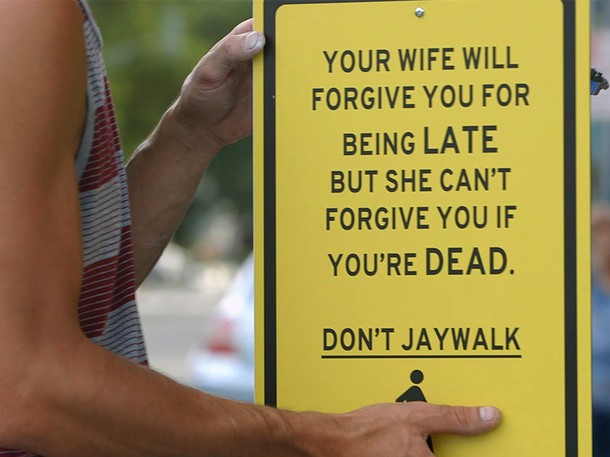New TV show uses design to fix everyday bad behavior
There are many, many reality shows that one could classify as “boring,” “ridiculous,” or “a complete waste of time showcasing the very worst of humanity.” But here’s one of the few that actually has some merit. Even without a clue as to the content, “Crowd Control” is aired on the respected and legitimate National Geographic Channel. It features experiments that test design, technology, and behavioral science on real world social problems that, so far, haven’t been solved.

The show uses signage to influence behavior. From National Geographic Channels.
The problems addressed are inherently interesting because anyone who lives in mainstream society (a demographic that likely includes most television viewers) has experienced them first-hand. Have you ever wondered why able-bodied people park in handicapped spots, even when they’re clearly marked as such? Or why it’s so unusual to see anyone give up a seat on a bus for a pregnant woman? How about the question of why people double-dip at parties? Or pee in pools? All of these are the sorts of problems “Crowd Control,” hosted by behavior expert Daniel Pink, seeks to examine and resolve when clearly posted signs, common courtesy, and common sense don’t have the desired effect.
According to this report, the “Crowd Control” experiments use all kinds of incentives to get people to do the right thing. Drivers are lured with the reward system, which offers music and potential monetary rewards for staying at the speed limit. Jaywalkers get talking street signs, which encourage them to obey traffic laws with enhanced verbal urgency, as well as video games that inspire them to stay put until the light changes. Potential bike thieves get life-like cardboard police officers acting as deterrents. And the show attempted to encourage office workers to exercise by placing a sign featuring a skinny stick figure by the stairs and a sign depicting a portly one by the escalator.
And where did all these off-the-wall ideas come from anyway? Turns out, some have actually been tested in real life already. Sweden has tried recording drivers on camera, to see which ones are obeying the law—and rewarding them by entering them in a sweepstakes. India uses cardboard police officers just like scarecrows to scare away bike thieves.
Does the show have all the answers to America’s social problems? Well, no. On the show, cardboard law enforcement is stolen. Stick figure signs are ignored. But the examination of these problems and solutions certainly sounds entertaining, and the ideas floated here are worth exploring.










